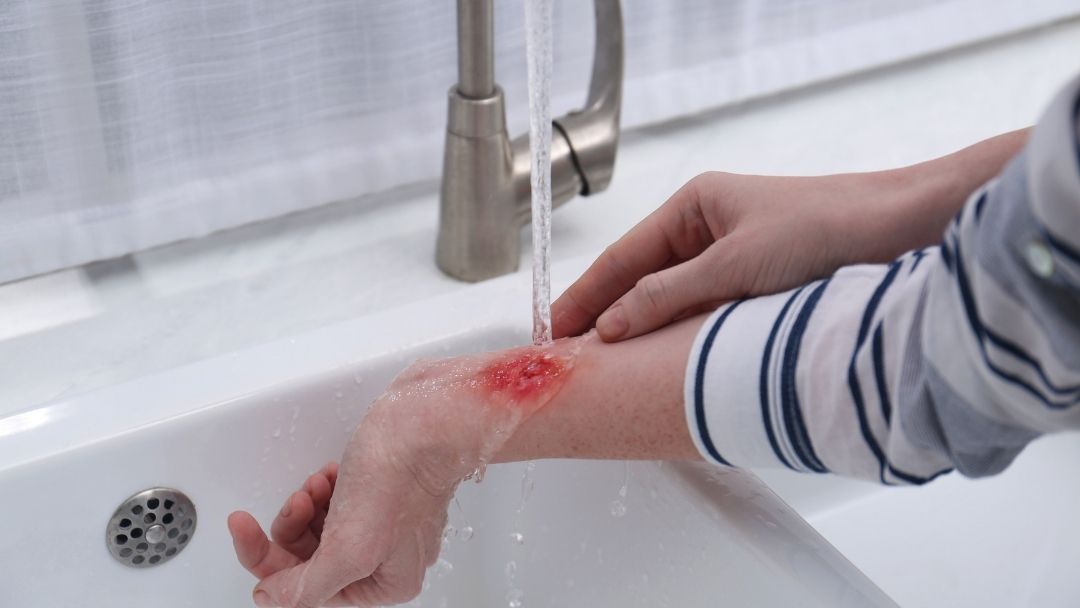Lanarkshire residents are being urged to be careful when they’re cooking their loved one a special dinner this Valentine’s Day – and have their first aid kits at the ready – to avoid an unplanned trip to A&E.
According to figures from Lanarkshire hospitals, at least 30 people a month turn up at emergency departments with burns and scalds and many will face waits of up to 12 hours to be seen.
The majority of patients could have easily treated the burns at home, with the help of a good first aid kit and advice from their local pharmacist.
Speaking about the number of people who attend Emergency departments at Lanarkshire’s three hospitals with burns and scalds, Calvin Lightbody, consultant in emergency medicine, said: “The majority of minor burns and scalds can be treated at home using cool water and painkillers which can be picked up from your local pharmacy.
“Your pharmacist may also be able to provide simple dressings if required.
“However, there are some occasions where you should visit an emergency department to receive treatment for a more serious burn: these include all chemical and electrical burns and any burn that is larger than your hand.
“You should also seek emergency treatment if your burn causes white or charred skin or causes blisters.
“People at greater risk from the effects of burns, such as children under five years old and pregnant women, should also get medical attention after a burn or scald.”
Many severe burns and scalds affect babies and young children but there are plenty of precautions that people can take to prevent burns and scalds in the kitchen or other parts of the home.
Speaking about the help that people can get from their pharmacist, George Lindsay, Chief Pharmacist, Primary Care, reiterated this advice: “Burns and scalds can be very sore and if not properly cleaned and dressed, it’s easy for them to become infected.
“Should anyone be worried about a burn or scald that does not fit the descriptions or circumstances outlined above, advice can be sought from your local pharmacist. They can also provide any medications if needed.
“Having a first aid kit in the house for immediate treatment is also recommended.”
Preventing burns and scalds
- Keep young children out of the kitchen and away from cookers, hobs, fireplaces, hot water, irons, tongs and curlers, and candles
- Fit safety gates across the doorway to the kitchen if you can, to keep young children out and when cooking, use the rings at the back of the cooker
- Use oven gloves to take hot dishes out of the oven and make sure you’ve got a good grip before you do so – and somewhere to put the dish down safely
- Take special care around naked flames: the gas hob, open fires, candles and so on
First aid for burns and scalds in the kitchen
- Remove any clothing or jewellery near the burnt area of skin but don’t try to remove anything that’s stuck to the burnt skin as this could cause more damage
- Cool the burn with cool or lukewarm running water – hold the burn under a running tap – for 20 minutes, as soon as possible after the injury. Never use ice, iced water, or any creams or greasy substances such as butter
- Cover the burn with a burn dressing if you have one, or cling film if you don’t – and then seek advice from your local pharmacist
- If appropriate take, paracetamolor ibuprofen for pain
There is useful self-care advice for anyone suffering a burn or scald on NHS Inform: https://www.nhsinform.scot/illnesses-and-conditions/injuries/skin-injuries/burns-and-scalds/
NHS 24 can deal with any urgent questions or concerns: call 111.
There’s also more information on NHS Inform www.nhsinform.scot and advice at www.nhs.uk.

